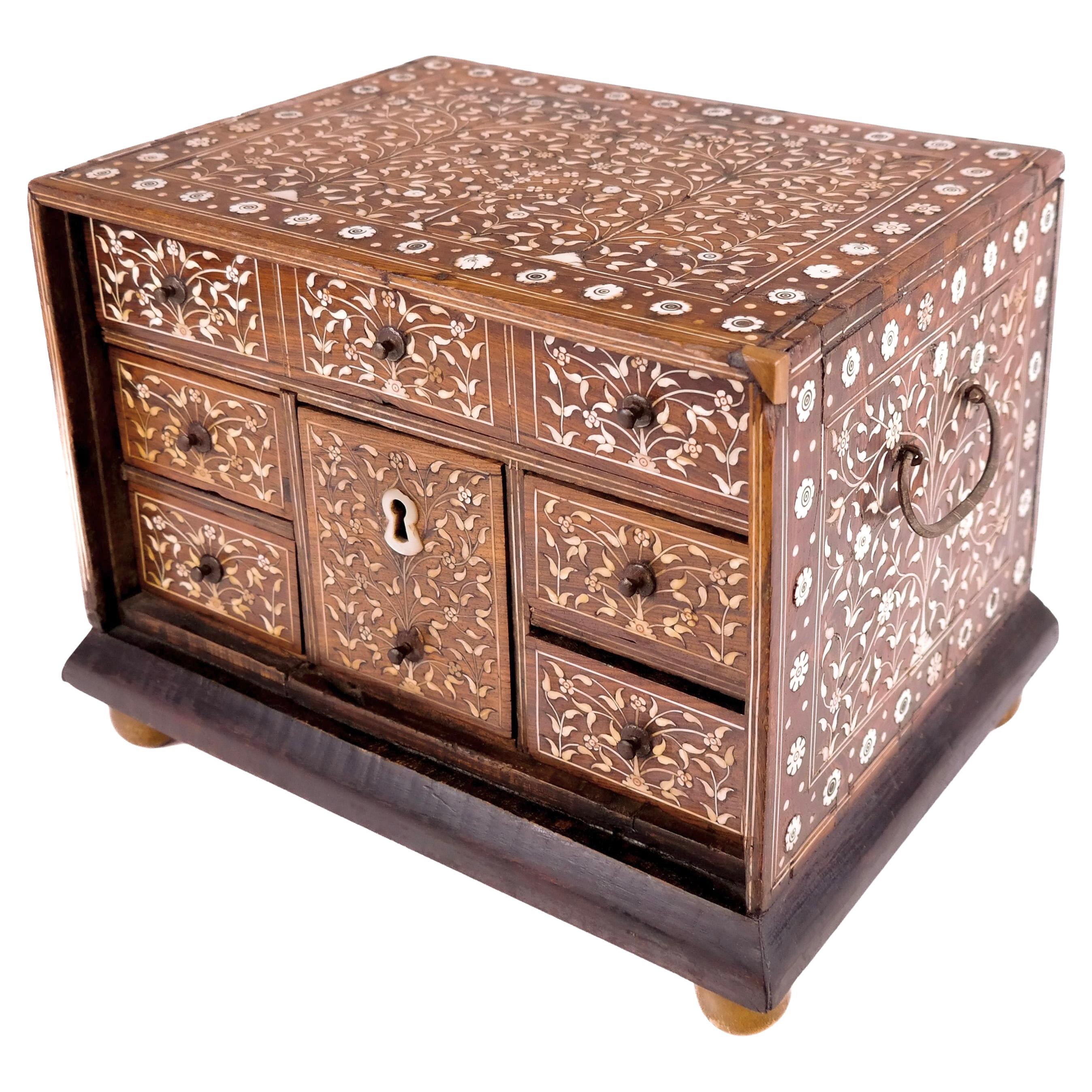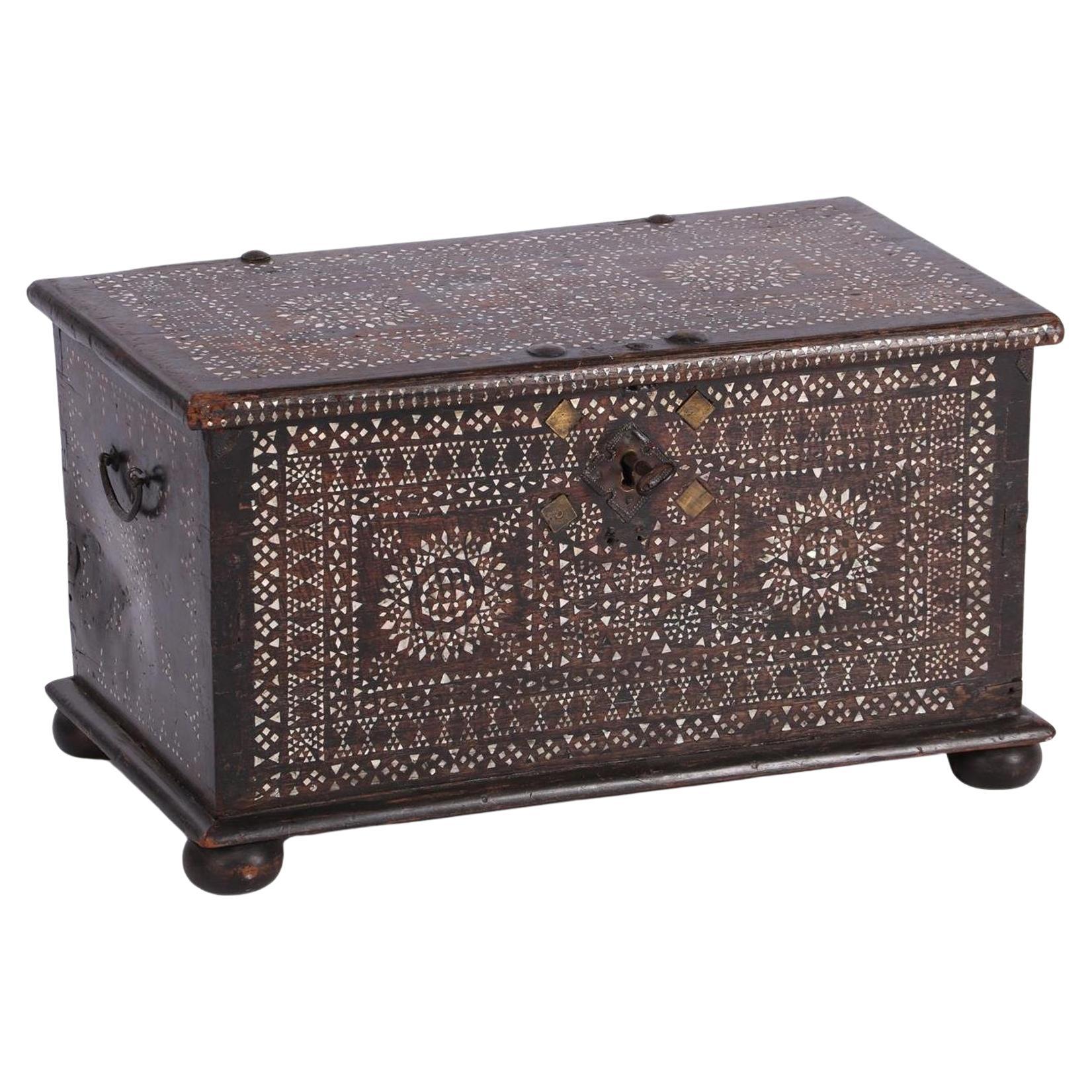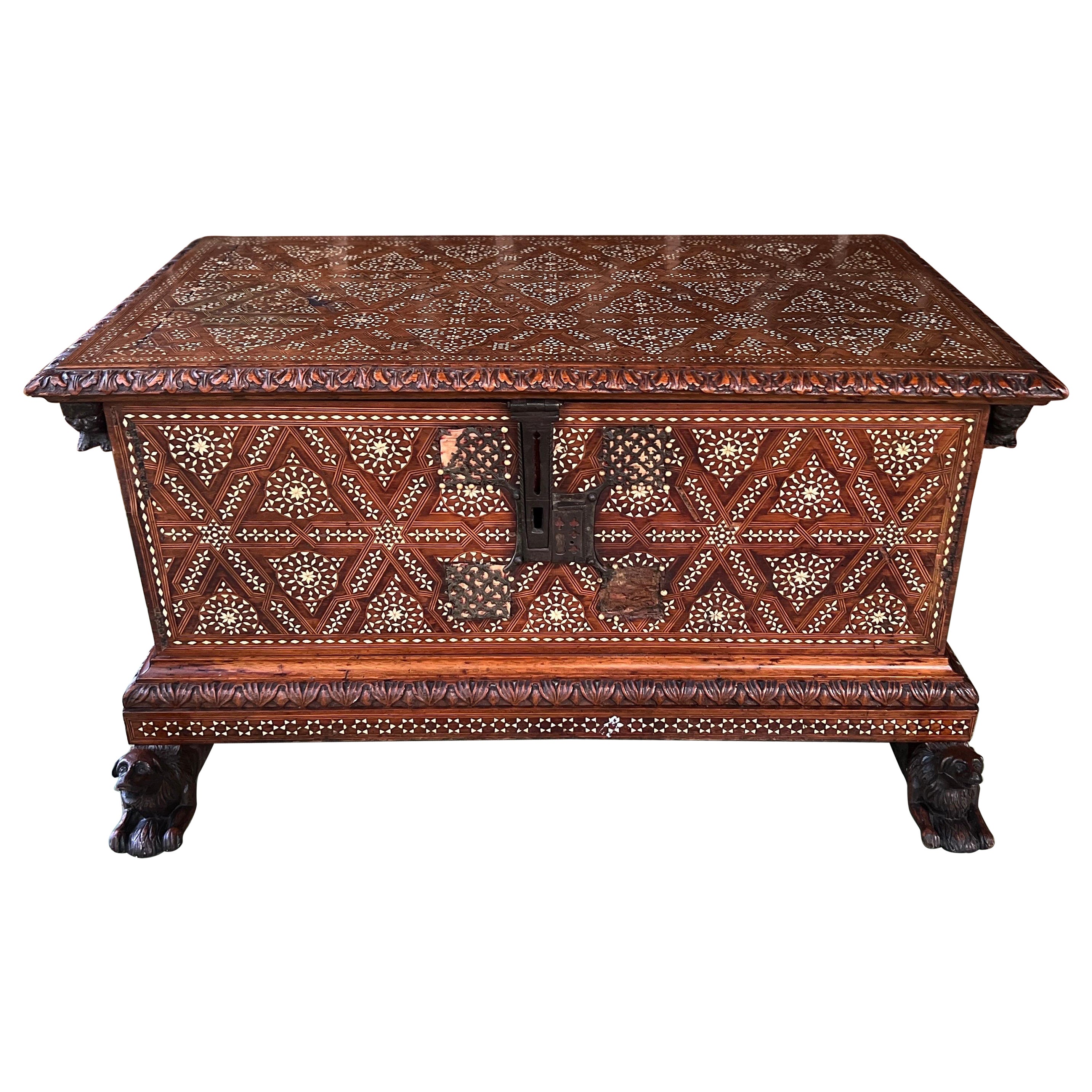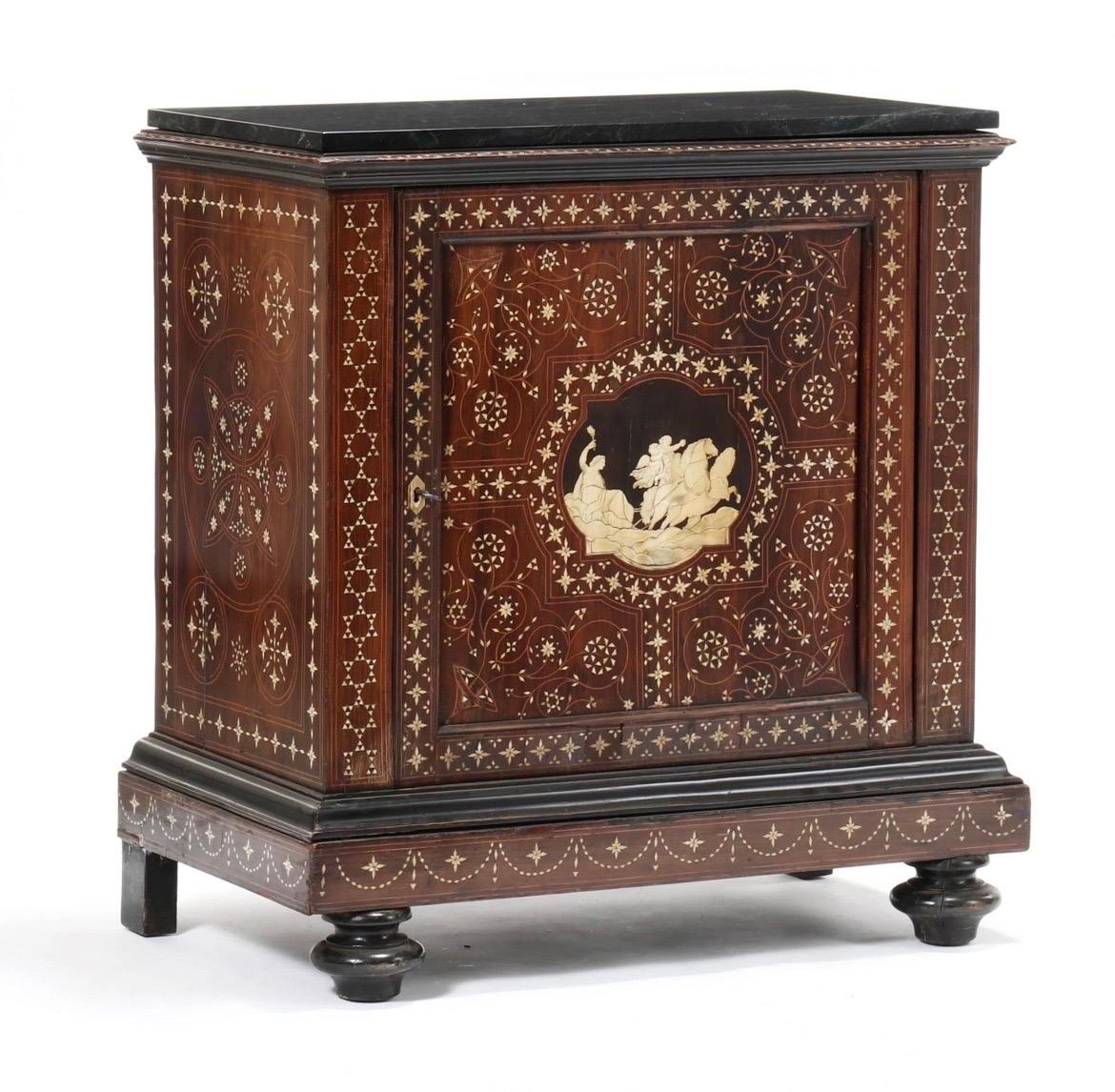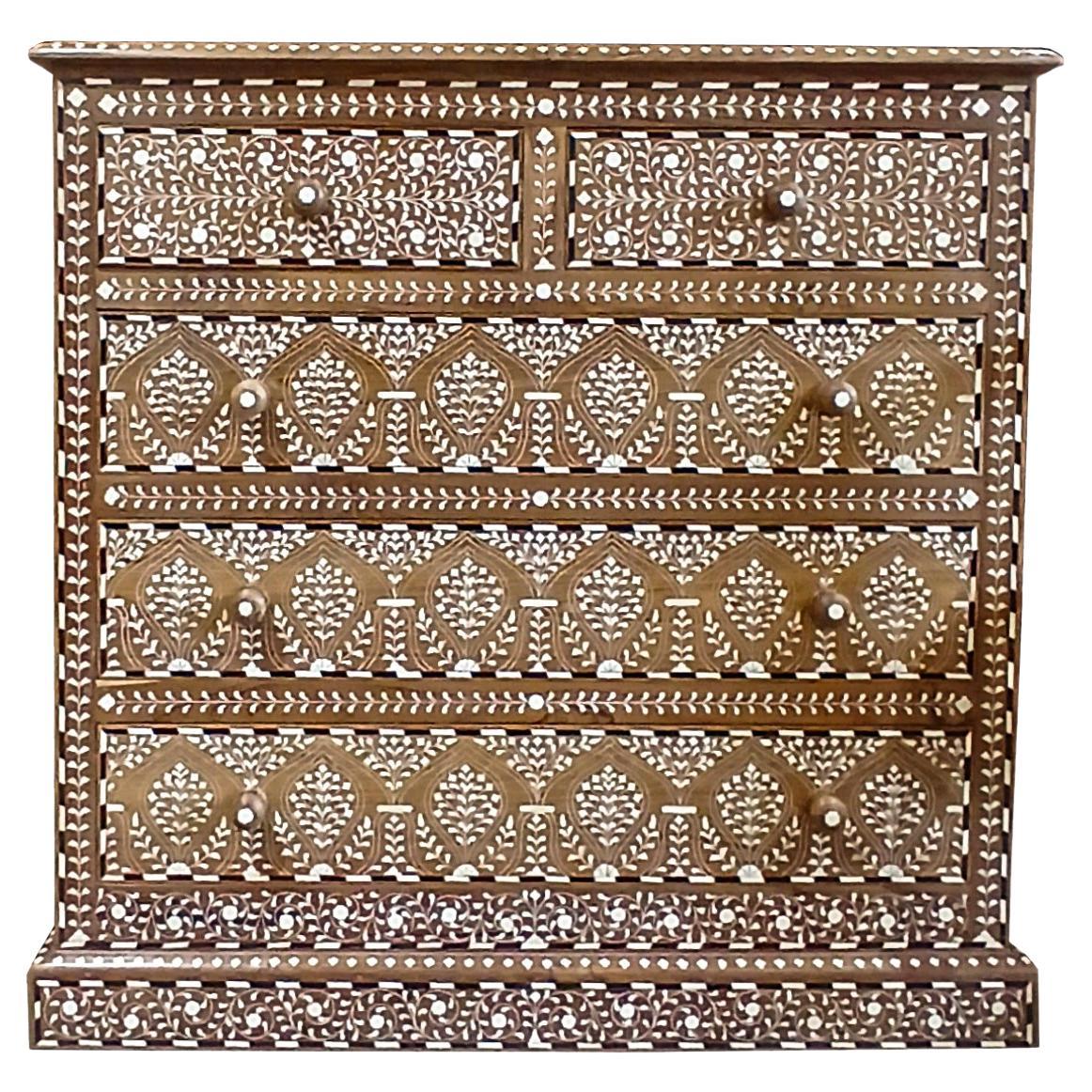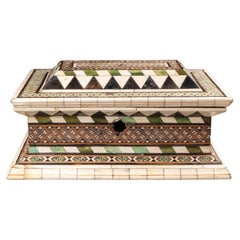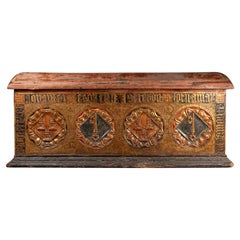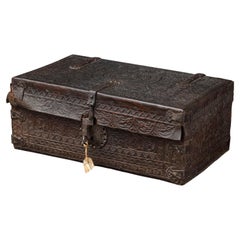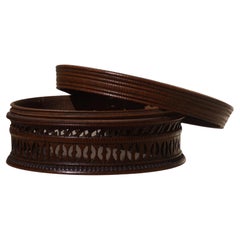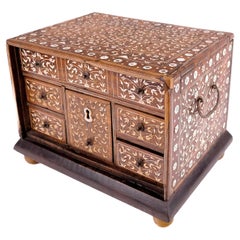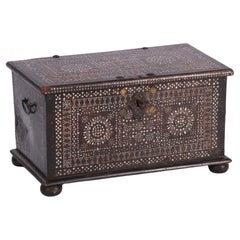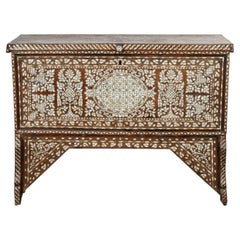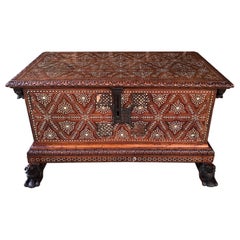Items Similar to Mughal Ivory Inlaid Wood Cabinet, 17th Century
Want more images or videos?
Request additional images or videos from the seller
1 of 5
Mughal Ivory Inlaid Wood Cabinet, 17th Century
$21,080.22
$26,350.2820% Off
£15,621.60
£19,52720% Off
€17,600
€22,00020% Off
CA$28,778.51
CA$35,973.1320% Off
A$32,014.91
A$40,018.6420% Off
CHF 16,782.62
CHF 20,978.2720% Off
MX$391,214.38
MX$489,017.9820% Off
NOK 213,705.69
NOK 267,132.1120% Off
SEK 201,174.34
SEK 251,467.9320% Off
DKK 134,004.85
DKK 167,506.0720% Off
Shipping
Retrieving quote...The 1stDibs Promise:
Authenticity Guarantee,
Money-Back Guarantee,
24-Hour Cancellation
About the Item
A Mughal ivory inlaid wood Cabinet
Noord-West Indie
17th century
27 x 40,2 x 30 cm
Cites number : 2023/BE00124/CE
Of rectangular form with fall-front opening profusely decorated in ivory inlay; sides with rectangular panels containing large inlaid ivory flowers within two border engraved with floral design; the front panel containing three large floral sprays surrounded by a double engraved border opening down to reveal eight drawers. This is a box that opens at the front to become a writing surface but also serving as a coffer in which to keep small precious objects such as jewelry or relics.
Produced in the north of India, in the region of the Great Mughal, this writing box adheres to a formal structure very close to that of European models.
While in India the colonial powers discovered, to their surprise, rare articles of courtly furniture richly worked and inlaid. However there was no local furniture that suited the settlers manner of living, so they commissioned extravagant pieces along European lines from native craftsmen, allowing them free rein with local materials.
Fall front cabinets such as this were designed to satisfy the demand of the settlers and many similar cabinets entered the collections of European aristocratic houses in the 17th and 18th centuries but they were also adopted by Indians, as seen in a Shah Jahan period miniature illustrated in Luxury Goods from India, the art of the cabinet maker, Amin Jaffer, 2002, p. 18.
This monumental fall-front cabinet was designed with an outstanding array of floral details. The popularity of flower studies in early seventeenth century Indian art followed on from a long-standing Mughal appreciation for flowers that since the days of Akbar had manifested itself in courtly painting and decorative arts but It was under Shah Jahan (r. 1628-58) however that the use of floral motifs were treated not as secondary decorative elements, but the primary focus of decoration. Jahangir's well-documented interest in flowers gave an added impetus to a group of artists and patrons already interested both in natural history and naturalism in painting. This is evident in the careful rendition of the floral stems on this example.
During Shah Jahan reign, similar floral motifs to those seen on our cabinet were found on a wide variety of media – such as the
The Saman Burj, Agra Fort (ca. 1637) decoration of buildings erected by the Emperor, for exemple the Saman Burj, Agra Fort (ca. 1637) or the Diwan-i ‘Amm in Ajmer as depicted in the Padshahnama (Milo Cleveland Beach and Ebba Koch, King of the World. The Padshahnama, exhibition catalogue, London, 1997, no.5, pp.28-29). By the second half of the 17th century similar motifs were popular also for cabinets (Basil Gray (ed.), The Arts of India, Oxford, 1981, p.180).
The resulting fusion of Western forms with Indian materials and decorative techniques gave rise to a wide range of luxury goods - cabinets, game-tables, painted boxes, ceremonial arms - that were breathtaking in their craftsmanship and widely prized in Europe.
With their intellectual curiosity and cultural policies, the Mughals were able to create a space of tolerance and harmonisation of different cultures.
This kind of cabinet illustrate the subtle interaction between European and Indian tastes and sensibilities, and chart the course of colonial patronage.
Bibliography:
Milo Cleveland Beach and Ebba Koch, King of the World. The Padshahnama, exhibition catalogue, London, 1997
Basil Gray (ed.), The Arts of India, Oxford, 1981
A. Jaffer, Luxury Goods from India: The Art of the Indian Cabinet-Maker, Victoria and Albert Museum, 2002
Brend in Arts of Mughal India : Studies in honour of Robert Skelton, ed. A. Topsfield, R. Crill, S. Stronge, London, 2004
- Dimensions:Height: 10.63 in (27 cm)Width: 15.83 in (40.2 cm)Depth: 11.82 in (30 cm)
- Style:Anglo-Indian (Of the Period)
- Materials and Techniques:
- Place of Origin:
- Period:
- Date of Manufacture:17th Century
- Condition:Repaired: Some inlaid ivory has been repaired. Wear consistent with age and use.
- Seller Location:Bruxelles, BE
- Reference Number:1stDibs: LU6666234253142
About the Seller
5.0
Vetted Professional Seller
Every seller passes strict standards for authenticity and reliability
1stDibs seller since 2022
15 sales on 1stDibs
Typical response time: 4 hours
- ShippingRetrieving quote...Shipping from: Bruxelles, Belgium
- Return Policy
Authenticity Guarantee
In the unlikely event there’s an issue with an item’s authenticity, contact us within 1 year for a full refund. DetailsMoney-Back Guarantee
If your item is not as described, is damaged in transit, or does not arrive, contact us within 7 days for a full refund. Details24-Hour Cancellation
You have a 24-hour grace period in which to reconsider your purchase, with no questions asked.Vetted Professional Sellers
Our world-class sellers must adhere to strict standards for service and quality, maintaining the integrity of our listings.Price-Match Guarantee
If you find that a seller listed the same item for a lower price elsewhere, we’ll match it.Trusted Global Delivery
Our best-in-class carrier network provides specialized shipping options worldwide, including custom delivery.More From This Seller
View AllEmbriachi workshop marquetry casket - Northern Italy, 15th century
Located in Bruxelles, BE
Embriachi workshop marquetry casket
Northern Italy, 15th century
Alla certosina inlays (bone, stained bone, pewter and wood)
H 28.2 x W 18 x D 14 cm
This beautiful casket of rectangular form is richly decorated with the characteristic geometric patterns of the Embriachi style.
The intricate geometric patterns are fashioned by juxtaposing lighter and darker pieces of wood, (colored) bone, horn and pewter. The lid and base are framed by a broad band of horn. When ivory became scarce in Europe due to disrupted trade routes, bone was substituted.
The attention to Symmetry and balance created an harmonious visual effect
Enhancing the overall aesthetic appeal of the casket.
The application of geometrical motifs is in Italy known as marquetry ‘alla Certosina’, named after the Certosina Church in Pavia with its famous altarpiece decorated in this way. This is ‘intarsia technique’, a term derived from the Arabic 'tarsi', which means ‘incrustation' recalling ancient mosaics made from various materials.
These geometric elements not only enhance the aesthetic appeal of the caskets but also demonstrate the versatility and skill of the artisans in creating multifaceted works of art.
‘Alla Certosina’ became famous through the Northern Italian Embriachi family who achieved a particularly high standard in working in this technique. Venice in particular was known for the production of these luxurious boxes. The caskets, hexagonal or rectangular, surmounted by a lid decorated in several registers constitute the secular, albeit equally renowned component of the workshop’s production, in addition to mirror frames and various everyday objects.
The method of fabrication of those objects was based on two concepts that underlay pre-industrial production: standardization and modularity, thanks to a distribution of skills according to the different phases of fabrication.
even the realization of the marquetry motifs (in the form of ingots from which portions of the desired size were cut) were therefore entrusted to various specialized craftsmen, as were the assembly phase.
Today better known thanks to the extensive research work recently carried out by Michele Tomasi, this workshop owes its name to its founder and owner, the Florentine Baldassare Ubriachi (or degli Embriachi), a merchant and banker established in the Tuscan capital before he settled in Venice in 1395. Together with sculptor Giovanni di Jacopo, who directed the workshop, from the last years of the fourteenth century, Baldassare oversaw a production that was truly original, and still easily recognizable today, comprising monumental altarpieces and various objects, primarily triptychs and caskets.
The precise location of the workshop is unknown, except that it originated in Florence and in ca. 1431 there was apparently a workshop in Venice, in the area of S Luca. They employed local workers specializing in 'certosina' (inlay of stained woods, bone and horn), and the workshop produced items carved in bone (usually horse or ox) with wood and bone marquetry.
The geometric decoration of Embriachi caskets reflects the artistic complexity and attention to detail that characterized their work.
this inlaid casket is a testament to the skill and artistry of the Embriachi family and serves as a stunning example of the decorative arts of the late Middle Ages.
Related Literature :
E. Berger, Prunk-Kassetten: Europäischen Meisterwerke aus acht Jahrhunderten / Ornamental Caskets...
Category
Antique 15th Century and Earlier Italian Renaissance Decorative Boxes
Materials
Pewter
$20,361 Sale Price
22% Off
Free Shipping
Rare pastiglia marriage chest - North of Italy, First half of 15th century
Located in Bruxelles, BE
Rare pastiglia marriage chest
North of Italy, Liguria or Piemonte
First half of 15th century
wood, gesso, partly gilded, form molded and painted
67 x 156 x 63 cm
Provenance :
Pri...
Category
Antique 15th Century and Earlier Italian Renaissance Blanket Chests
Materials
Gesso, Wood
Boiled Leather Trunk, Spanish, 17th Century
Located in Bruxelles, BE
Leather trunk
Spanish, 17th century
Boiled Leather, wood and iron
Measures: 22 x 53 x 32 cm.
Provenance :
- collection Metz-Noblat, Château de Clevant, France
Rectangular trunk of the form and size of a small suitcase with wrought iron hinges and lock-plate.
Wood, covered with leather, cut and embossed with every surface of the thick cow hide covered in interlace, zoomorphic features.
The construction method is boiled leather, often referred to by its French translation cuir-bouilli: a process used to change flexible, vegetable-tanned leather into rigid, moulded objects. For shaping of the vegetable-tanned leather, heat and moisture were used, as indicated by the term boiled leather. No written medieval sources describing the production of decorated cuir bouilli objects survive, so knowledge of the process relies on the important studies of the Scottish leather historian John William Waterer. A large range of methods, materials and techniques could be used in various combinations. The vegetable-tanned leather, made supple with moisture and heat, was stuffed, shaped and nailed to the rigid wooden coffer support. The stuffing material was probably modeled beeswax or stearin wax. To shape the leather, to create its topography, « Cushions » were made by lacing a thread through an awl hole and attaching the flexible leather and stuffing to the rigid wooden support on the bottom. Then the decoration was done: lines were incised through the upper layer of the leather (epidermis) with different thicknesses of knives or needles. Contours were created with deep v-shaped cuts, decoration with thin incision and final details with a needle point. For the incision and pouncing stage, the leather was probably kept heated and moistened for suppleness.
Once dry, the leather would be hard and rigid.
the saturated leather is worked over a form, possibly even damp sand, with the pattern shaped using bone or wooden tools. Compare to metal, leather was lighter and it offered protection from cuts and punctures. Cuir bouilli objects were produced by specialist leather workers and needed skillful craftsmanship.
The surface is filled with roundels shaped foliages enclosing animals, lions and peacocks. The foliate arabesques creating a vegetal connection tweet the animals create the impression of a lush verdant space . The vegetal pattern here employed in combination with geometrical pattern came from the pre-islamic artistic traditions of the Byzantine and Sasanian empires. An aspect of Islamic geometry Is the basic symmetrical repetition and mirroring of the shapes that create a sense of harmony.
The decoration of this truck is inspired by the islamic « arabesque » a form of vegetal ornament composed of spirals, intertwining plants and abstract curvilinear motifs. An arabesque character is given to the birds of the decorations through extreme stylisation. This arabesque maintained the classical tradition of median symmetry, freedom in Detail and heterogeneity of ornament.
The presence of the peacocks is a paradisiacal allusion: in popular Islamic literature they were among the original inhabitants of the garden of Paradise expelled with Adam and Eve. Peacock as a decorative motif may have originated in the West, despite their eastern provenance. There was an ancient belief that the flesh and feathers of peacock do not decay. This led to the peacock becoming a christian symbol for Christ’s resurrection.
Renowned for their decorative wall hangings, seventeenth-century Spanish leatherworkers also produced utilitarian objects, such as this trunk. A similar trunk is on display at the Metropolitan museum of art ( 09.158.1).
Related literature :
Davies L. 2006. Cuir bouilli. Conservation of leather and related materials, 94-102, Oxford: elsevier Butterworth-Heinemann
Grabar, Oleg. The Mediation of Ornament. Princeton: Princeton University Press, 1992
Gabriela Germana Roquez, "El mueble en el Peru en el siglo XVIII...
Category
Antique 17th Century Decorative Boxes
Materials
Iron
Turned, Engraved Openwork Box, Florence, 17th Century
Located in Bruxelles, BE
Turned, engraved and openwork box
Fruit wood
Florence, 17th century
Measures: Diameter 11cm
Height 4.4cm.
Category
Antique 17th Century Italian Renaissance Decorative Boxes
Materials
Wood
$766 Sale Price
20% Off
17th century wood and black marble table - North of Italy
Located in Bruxelles, BE
Walnut and marble table
North of Italy, 17th century
Wood and black marble
H 80,5 x L 114 x P 58 cm
This elegant table features a one single solid marble top directly mounted on f...
Category
Antique 17th Century Italian Baroque Side Tables
Materials
Marble
Decorative Carved Panel - France, 19th Century
Located in Bruxelles, BE
Decorative Carved Panel
France, 19th Century
15,5 x L 30,5 x 3 cm
Carved in richly grained wood, this 19th-century decorative panel draws direct inspiration from Renaissance ornamen...
Category
Antique Early 19th Century French Renaissance Wall-mounted Sculptures
Materials
Wood
You May Also Like
Inlaid Table Cabinet
Located in Bradenton, FL
Inlaid table cabinet with six compartments and two handles. This is a beautifully decorated crafted box reflecting the craftsmanship and cultural influences of Goa during the colonia...
Category
Antique 19th Century Indian Anglo-Indian Decorative Boxes
Materials
Mother-of-Pearl, Wood
$1,885
19th Century oriental chest inlaid with mother of pearl
Located in Diest, BE
19th Century Syrian oriental chest inlaid with mother of pearl. Handcrafted Middle Eastern wedding gift from parent to the bride. Great patina.
Category
Antique 19th Century Syrian Islamic Blanket Chests
Materials
Iron
Antique Syrian Mother of Pearl Inlay Wedding Trunk
Located in North Hollywood, CA
Rare antique 19th century mother of pearl inlaid Syrian blanket wedding chest. Very fine intricate, detailed, stunning craftsmanship quality of Syrian Moorish artwork. Unusual ottoma...
Category
Antique 1890s Syrian Islamic Blanket Chests
Materials
Shell, Wood
Museum Quality 18th Century Syrian Anglo Indian Carved & Inlaid Blanket Chest
Located in Atlanta, GA
Syrian / Anglo Indian, 18th century or earlier.
The finest quality Syrian Anglo Indian blanket chest I have come across in my career. Featuring an incredible geometric bone inlaid ...
Category
Antique 18th Century Blanket Chests
Materials
Iron
$4,716 Sale Price
20% Off
Magnificent 19th Century Italian Grand Tour Rosewood & Bone Inlaid Cabinet
Located in Atlanta, GA
Italian, circa 1900.
A fantastic rosewood veneer and ebonized hardwood cabinet. Rectangular form with later dark green marble top, applied upper molding above a single hinged panele...
Category
Antique 19th Century Italian Anglo-Indian Cabinets
Materials
Wood
$3,840 Sale Price
20% Off
Inlaid Teak Chest of Drawers from India
Located in New York, NY
A charming 5-drawer chest, handcrafted in India out of aged teak wood and cruelty-free, responsibly sourced buffalo bone inlays.
Inlay is ancient decorative technique that involves...
Category
2010s Indian Anglo-Indian Commodes and Chests of Drawers
Materials
Bone, Teak
More Ways To Browse
Antique Ivory
Antique Inlaid Wood Furniture
Used Luxury Goods
Wood Artist Model
Inlaid Flower
Mughal Furniture
Indian Painted Wood
18th Century Inlay Cabinet
Antique Kitchen Range
Floral Carved Wood Cabinets
India Wood Inlay
17th Century Wood Panels
Antique Mughal
17th Century Carved Cabinet
Free Standing Cabinet
Antique Curiosity Cabinet
Antique Miniature Houses
Used Furniture Long Beach
